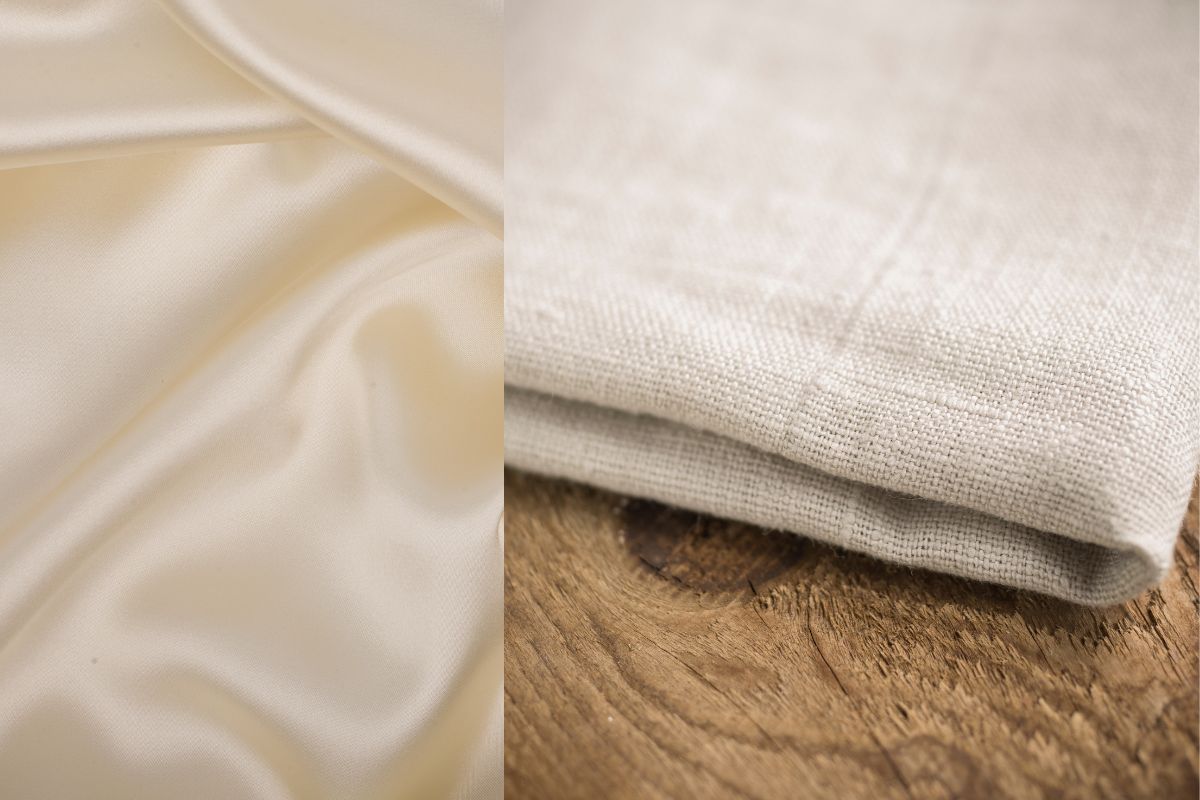Ecru, derived from the French word for “raw” or “unbleached,” is often described as a pale, warm, and off-white color. It exudes a sense of elegance and sophistication, making it a popular choice in the world of fashion and interior design.
The origin of ecru color can be traced back to the textile industry, where it was used to describe fabrics in their natural, unbleached state. Unlike pure white, which can sometimes appear stark or clinical, ecru has a softer and more natural appeal. It’s this warm undertone that sets ecru apart from other shades of white and makes it a versatile option for various applications.
Ecru is created by combining white with small amounts of other colors, such as yellow or brown. This subtle infusion of pigments results in a shade that is neither too bright nor too dull. The precise composition of ecru can vary, and different manufacturers may have slightly different interpretations of the color. However, the overarching characteristic remains the same – a soft, warm, and inviting hue that sits comfortably between white and beige.
Different Shades and Variations of Ecru Color
While ecru is generally described as a pale, warm, and off-white color, there are different shades and variations within the ecru spectrum. These subtle differences can be influenced by factors such as the specific pigments used or the lighting conditions in which the color is observed.
Some variations of ecru include:
- Light Ecru: This shade of ecru leans towards a lighter, more delicate appearance. It can bring a sense of airiness and freshness to a space or outfit.
- Dark Ecru: On the other end of the spectrum, dark ecru has a richer and deeper undertone. It can add a sense of warmth and coziness to a room or ensemble.
- Warm Ecru: Warm ecru has a slightly yellowish hue, adding a touch of sunshine and vibrancy to any setting.
- Cool Ecru: Cool ecru has a hint of grey or blue undertones, giving it a more muted and calming appearance.
The specific shade of ecru you choose will depend on your personal preferences and the desired mood or aesthetic you wish to create.
Ecru Color in Fashion and Design
The world of fashion has long embraced the timeless beauty of ecru. Its understated elegance makes it a favorite choice for bridal gowns, evening wear, and classic tailored pieces. Ecru garments exude sophistication and refinement, offering a subtle alternative to pure white.
In interior design, ecru is equally beloved. Its neutral nature allows it to seamlessly blend with a range of color schemes, making it a versatile choice for walls, upholstery, and accessories. Ecru can soften a room while adding a touch of warmth and sophistication. Whether used as the dominant color or as an accent, ecru can create a sense of tranquility and timeless beauty in any space.
Ecru Color Symbolism and Meaning
Colors often carry symbolic meaning, and ecru is no exception. This pale, warm hue is associated with qualities such as purity, simplicity, and elegance. It radiates a sense of calmness and sophistication, making it a popular choice for those seeking a refined aesthetic.
In some cultures, ecru represents new beginnings and rebirth. Its association with purity and simplicity makes it a fitting choice for occasions such as weddings and christenings. Additionally, ecru is often seen as a color of understated luxury, evoking a sense of refined taste and elegance.
Ecru Color in Interior Design
When it comes to interior design, ecru is a versatile color that can be used in various ways to create different effects. As a neutral hue, it can serve as a backdrop for bolder elements or stand on its own to create a serene and harmonious environment.
For those seeking a minimalist aesthetic, ecru can be used as the primary color for walls and large furniture pieces. Its subtle warmth adds depth and interest without overwhelming the space. To create a cozy atmosphere, pair ecru with warm tones like caramel or chocolate brown. Alternatively, combine it with cool blues or greens for a more refreshing and contemporary feel.
When using ecru as an accent color, it can be incorporated through textiles, such as curtains, rugs, and throw pillows. This allows for easy customization and flexibility as trends change or personal preferences evolve. The versatility of ecru makes it a timeless choice that can adapt to any design style, from traditional to modern.
How to Incorporate Ecru Color in Your Wardrobe
Just like in interior design, ecru can be a valuable addition to your wardrobe. Its neutral nature allows it to pair effortlessly with a range of colors, making it a versatile choice for both casual and formal outfits.
For a classic and sophisticated look, opt for ecru trousers or a skirt paired with a crisp white blouse. This combination exudes elegance and can be dressed up or down depending on the occasion. To add a touch of warmth, layer ecru knitwear or outerwear over neutral or pastel tones.
If you prefer a more casual ensemble, ecru can be incorporated through accessories like shoes or handbags. These neutral accents can elevate a simple jeans and t-shirt combination, adding a touch of refinement and sophistication.
Popular Ecru Color Combinations
Ecru is a versatile color that can be paired with a wide range of hues to create different moods and aesthetics. Here are some popular ecru color combinations that can inspire your next design or fashion project:
- Ecru and Navy: The contrasting combination of ecru and navy creates a timeless and sophisticated look. This pairing works well in both fashion and interior design, evoking a sense of classic elegance.
- Ecru and Blush Pink: This soft and delicate combination exudes romance and femininity. It’s a popular choice for weddings and other special occasions, creating a dreamy and ethereal atmosphere.
- Ecru and Olive Green: The earthy tones of ecru and olive green create a natural and organic feel. This combination is perfect for those seeking a calming and grounding aesthetic.
- Ecru and Charcoal Gray: The pairing of ecru and charcoal gray offers a modern and sleek look. This combination is often used in contemporary interior design, adding a touch of sophistication and refinement.
Ecru Color in Art and Literature
Ecru has inspired artists and writers throughout history. Its timeless elegance and warmth have made it a favorite choice for capturing subtle nuances and emotions.
In art, ecru is often used as a background color to highlight and enhance other elements. It provides a neutral base that allows vibrant colors to pop, creating a visually striking composition. Additionally, ecru can be used to evoke a sense of nostalgia or to depict a timeless and serene atmosphere.
In literature, ecru is often used to describe settings or objects that exude elegance and refinement. It paints a picture of sophistication and understated beauty, transporting readers to a world of timeless charm.
Conclusion: Embracing the Versatility of Ecru Color
Ecru, with its subtle warmth and timeless appeal, is a color that deserves recognition and appreciation. Whether in fashion, interior design, art, or literature, ecru adds a touch of sophistication and elegance to any context.
Understanding the nuances of ecru color allows you to make informed choices when incorporating it into your designs or outfits. From creating harmonious color palettes to evoking specific emotions, ecru offers endless possibilities.
So, the next time you find yourself pondering the color ecru, remember its origins, symbolism, and versatility. Embrace the beauty of this intriguing hue and let it add a touch of timeless elegance to your surroundings.

